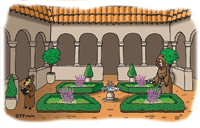 Holiday catalogs barely seem to ebb in number before the typical gardener’s mailbox is filled with dozens of seed and garden catalogs bursting with gleaming copper obelisks, Chinese Giant Peppers, and a host of tantalizing plants, tools, and often wacky products.
Holiday catalogs barely seem to ebb in number before the typical gardener’s mailbox is filled with dozens of seed and garden catalogs bursting with gleaming copper obelisks, Chinese Giant Peppers, and a host of tantalizing plants, tools, and often wacky products.Garden catalogs are the remedy for winter blues. Just turn a few pages and encounter luscious blueberries while the Arctic winds of winter howl. Pick up another catalog and the folks at Van Bourgondien will dazzle you with their “dinner plate” dahlias, each rainbow-tinted bloom larger than a cherubic child’s head.
Mail-order catalogs can also be important tools for the aspiring horticulturist seeking colorful dwarf conifers, heirloom vegetables, or disease resistant plant cultivars. Local garden centers, despite fine reputations and choice offerings, can never match the variety of plant and garden materials available through catalogs and Internet sources.
At one time, Barbara Barton’s classic Gardening by Mail: A Source Book, served as an unparalleled guide to mail-order garden suppliers. Now in its fifth edition, it is hard-challenged by the numerous compendia of catalogs found online. GardenGuides.com is a typical site which provides extensive listings of catalogs, ranging from traditional sources such as Burpee, Park Seeds, Stokes Seeds, and so on, to specialty growers and suppliers, such as Seeds of Change, the Antique Rose Emporium, or the Thomas Jefferson Center for Historic Plants. After all, who can hold a bulb to Bobba-Mike's Garlic Farm with 38 different strains of organically grown gourmet garlic? And your local nursery can never hope to rival the bloodthirsty inventory of Cook’s Carnivorous Plants.
If there is a niche to be filled, there is a catalog (or ten) available. For example, tomatoes are a mainstay of most vegetable gardens, and catalogs like Totally Tomatoes offer 80 pages of selections, from Big Zac Hybrids with fruits weighing in at four to six pounds each, to Micro Tom Hybrids, a six inch tall plant covered with pea-size fruits.
Gardeners who favor landscapes that are both tasty and unique have long found a champion in Mike McConkey’s Edible Landscapes, where hedges can be grown from currants and jostaberries, arbors covered by maple-red leafed Russian kiwis, and entryways brightened by Regent Juneberries. Similarly, Nichols Garden Nursery features a catalog of seeds, live herb plants, and other gourmet materials specifically grown for the gardener cook.
Some of the most stunning catalogs come from upscale nurseries like Bluestone Perennials, Logee’s Greenhouses, Wayside Gardens, and White Flower Farm. Each brilliant page is a siren call to rip up that boring old lawn and replace it with sweeping perennial beds shimmering with ruby, pink, and purple asters, or living mounds of white, salmon, and vermillion dianthus hybrids.
Catalogs range in feel and style as much as in plant or product selections. R.H. Shumway’s Illustrated Garden Guide is an oversize publication rich in tradition, where engraved plate illustrations harken back to the company’s origins 133 years ago. More homespun and academically-oriented nurseries such as Garden Medicinals and Culinaries only print a catalog every several years and rely on black and white photocopied updates to announce the availability of endangered species like Blue Cohosh, sweet-scented Vanilla Grass or Black Hollyhocks from the pre-1830s.
Naturally, gardens require more than seeds and plants. The multi-billion dollar world of garden equipment supplies, from hose reels, garden carts, and do-it-yourself greenhouses, includes respected firms like Gardener’s Eden and Smith and Hawken, while a less expensive and personal favorite, Gardener’s Supply Company, long famous for its compost bins, planters, garden ornaments, and seed-starting supplies offers a catalog echoing its corporate mantra of non-toxic pest control and organic gardening techniques.
Of course, Gardener’s Supply is in good company with Garden’s Alive, Necessary Organics, and a host of firms dedicated to resource conservation and environmental solutions to pests and other problems.
The world of garden accessories has some distinctly kitschy byways. Upscale catalogs offer Parisian street lamps, topiary forms, plantation grown teak furnishings, or enameled Mexican chimenea, while further down the rabbit hole we find garden sculpture crafted from dried cow manure, human-scale outdoor chess sets, faux marble statuary, vinyl balustrades, and the Amazing Floating Gazebo which “appears to float in your yard!”
With a new gardening season on its way, consider some of the creative possibilities which are just a few catalog pages, mouse-clicks, and credit card charges away. Surprise mom on Mother’s Day with a Clara Barton Redbud from the Historic Trees Nursery, a hand-painted hummingbird feeder, or perhaps a miniature tree rose from Tiny Petals Nursery. If you can still recall conditions last summer, you might want to treat yourself to the catalog of High Country Gardens, which offers hundreds of drought tolerant, xeriscape plants, along with design plans.
Catalogs can help you go solar, with solar-powered sprays for fountains, walkway lighting, or patio accent lights. They can help you save water with rain barrels and drip irrigation supplies. They can help you find unusual plants, attractive rain gauges, or reasonably priced sundials.
Or you can simply turn your back on good taste and respectability and either purchase a flock of pink flamingos or choose from one of the many catalogs featuring dozens of garden gnomes involved in mostly PG-rated activities.
Copyright 2009, Joseph M. Keyser



